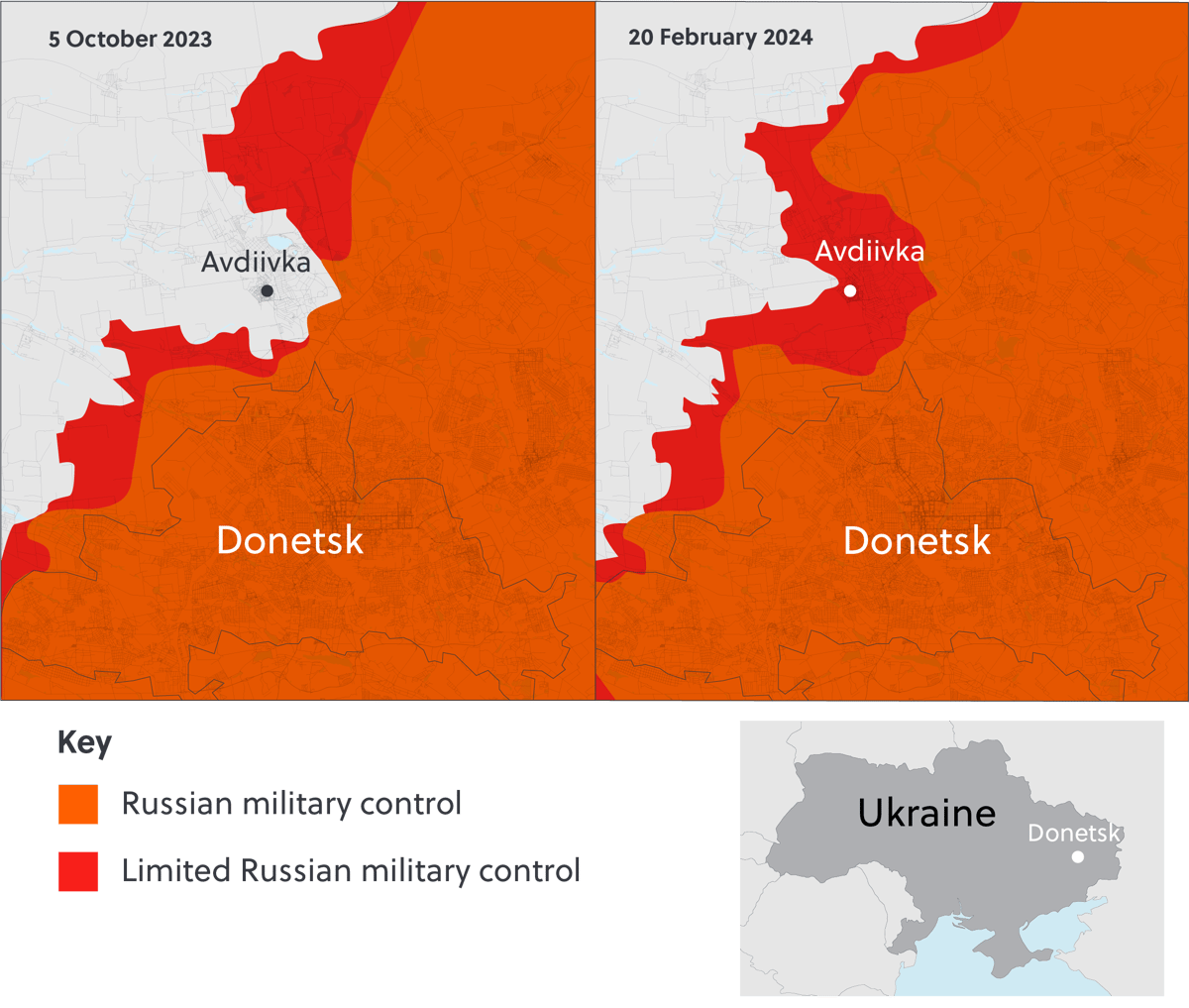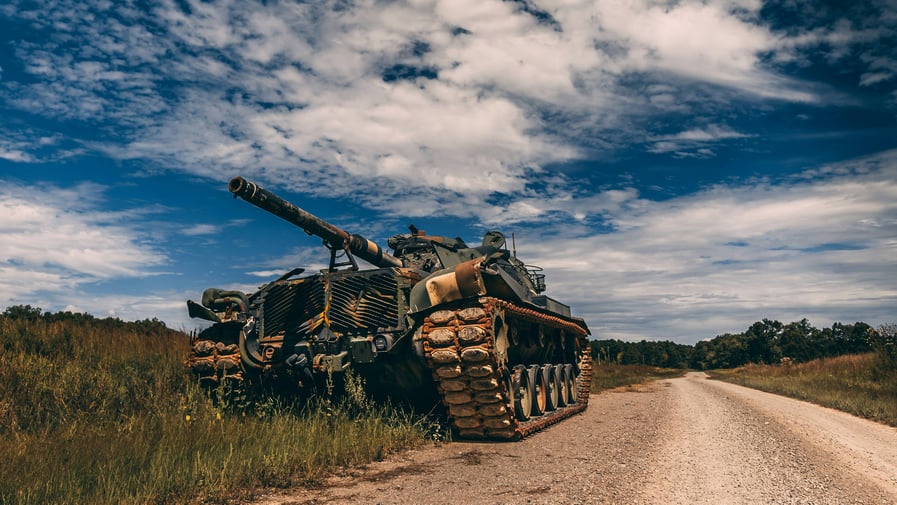The start of 2024 has not been easy for Ukraine, underscored by continued weapons shortages and the loss of Avdiivka in Donetsk Oblast. Richard Gardiner considers Ukraine’s defence prospects in 2024 and its ability to expose Russia’s looming challenges in 2025 and beyond.
In February, Ukrainian forces withdrew from Avdiivka in Donetsk Oblast, marking Russia’s most significant territorial advance since it captured Bakhmut in May 2023. Russian forces are unlikely to stop in Avdiivka. Sensing vulnerabilities in Ukraine’s ability to defend the nearly 1,000 km-long line amid severe munitions shortages, Russia – with a substantially expanded defence budget - will likely seek to press home its advantage and make further gains. However, Russia too faces growing challenges in its long-term ability to sustain its offensive operations in Ukraine, leaving the door open for Ukrainian forces to turn the tables in 2025 and 2026 should the war persist, and provided that Ukraine receives adequate support from its western partners. As a result, Ukraine’s task for 2024 is clear: hold the line.
Russian advances around Adiivka from October 2023 to February 2024

Ukraine under pressure
Despite its slow progress and limited territorial gains over the past two years, Russia still maintains its central objective in the war: the subjugation of Ukraine. This objective was recently underscored by Russian Security Council Deputy Chairperson Dmitry Medvedev, who advocated for the total elimination of the Ukrainian state and its subsequent incorporation into Russia. While Russian forces have encountered significant equipment and personnel losses and made stuttering progress, recent territorial gains have bolstered Russia’s confidence that it can further its objectives by exploiting the delays in western support for Ukraine. Meanwhile, Ukrainian forces are growing increasingly desperate as their European partners have yet to boost production of munitions to meet Ukrainian requirements, and a key military funding package worth USD 60 billion is stalled in US Congress, leaving Ukraine short of crucial supplies, including artillery shells crucial to defending territory.
Ukraine’s shell hunger assisting Russia’s gains
Based on current requirements, Ukraine needs around 200,000 artillery shells per month to mount a convincing defence. However, amid recent shortages, Ukrainian forces have had to ration their rate of fire to 2,000 shells per day, leaving many parts of the Ukrainian frontline with no artillery coverage at all. Not only does this reduce Ukraine’s ability to thwart Russian advances, but it also requires more personnel to occupy defensive positions, resulting in further casualties and stretching the defensive line even thinner, while also eroding the potential for future offensive operations.
Ukraine’s munitions shortage was a contributing factor to the Avdiivka retreat. In the wake of the withdrawal, US President Joe Biden issued a statement citing congressional inaction as the reason for Ukraine’s dwindling ammunition supplies and Russia’s first notable advance in months. Biden has attempted to use this setback to build pressure on Republican members responsible for obstructing funding; however, their stance is yet to change and without further support in the coming months further Russian territorial gains are likely.
Russia on the move
Russia’s advances will provide it with useful leverage in future potential ceasefire discussions, forcing Ukraine to negotiate from a position of weakness. It is likely that Russian forces will target eastern Ukraine, particularly the Donetsk Oblast, in their efforts to establish full control over the Donbas region. While Ukraine has had success in targeting Russia’s naval and military assets in Crimea and in the Black Sea in recent months, the benefits of these strikes, which include reduced Russian air support, are unlikely to substantially impact Russia’s ability to conduct ground offensives. Instead of one large, coordinated operation, Russian forces will look to carry out multiple small-scale offensives seeking to find vulnerabilities in Ukrainian lines, which are not nearly as well fortified as Russia’s defensive positions. If Russia succeeds in further advances and pressures Ukraine to negotiate, Kyiv may be compelled to make significant concessions, which may include territorial losses and a pledge to not join NATO. However, there is no guarantee Russia will honour the terms of future deals. With renewed confidence and the opportunity to rebuild forces, Russia would be emboldened to make another attempt at achieving its stated objectives in Ukraine in the future.
A glimmer on the horizon?
Despite Ukraine’s current predicament, all is not lost. Provided Ukraine makes it through 2024 relatively unscathed, it would be in a position to capitalise on some of Russia’s own challenges in 2025 and 2026. This highlights the importance of the US aid package, which if approved would mean an extra 1.3 million rounds of artillery shells, likely enough to help Ukraine hold the line in 2024. Furthermore, Europe’s defence industry is expected to grow over the next two years, which in concert with continued US support, could allow Ukrainian forces to go back on the offensive in 2025. There are also ways in which western partners could assist Ukraine without directly providing military equipment, such as collaborating with Ukraine to reform and improve training programs, or assisting in expanding the domestic production of Ukrainian drones which would partly offset artillery shortages.
Moreover, while Russia is expected to make further territorial gains over the coming months, these advances will likely be slow and arduous due to persistent capability gaps in their offensive potential. Russia’s capture of Avdiivka involved significant losses of personnel and equipment, as they employed tactics aimed at overwhelming Ukrainian lines with their numerical advantage, rather than employing a high level of tactical astuteness.
Equipment challenges are likely to mount for Russia too. Many of the current deliveries of armoured personnel carriers (APCs) and tanks are refurbished Soviet-era models rather than newly built vehicles. With such high attrition levels of equipment due to its battlefield tactics, the demand for tanks and APCs will continue to grow. However, deliveries are likely to drop in 2025 and 2026 as the old Soviet stocks run dry, and Russia fails to expand its capacity to build new models. Additionally, while Russia maintains a significant advantage over Ukraine in terms of artillery shells, it may face challenges in 2025 due to shortages of artillery pieces, stemming from limited capacity to forge new barrels. This suggests that Russia’s greatest opportunity for significant gains in Ukraine is in 2024, before its offensive potential degrades due to its production deficiencies. But at the same time, these challenges could allow Ukraine to weather the storm and hold out until 2025.
Provided Ukraine makes it through 2024 relatively unscathed, it would be in a position to capitalise on some of Russia’s own challenges in 2025 and 2026.”
Looking ahead
Ukraine will first have to endure short-term hardships, including further territorial losses, to capitalise on potential long-term opportunities. This is by no means a simple task, and achieving a positive outcome will require further Ukrainian resilience, the maintenance of national morale, and ensuring Ukraine’s forces have a sustained flow of new recruits to bolster its flagging forces. Furthermore, Ukraine’s success is also premised on the collective political will in North American and European capitals to continue supporting Ukraine. This support is not guaranteed, especially with the potential return of Donald Trump to the White House in January 2025. However, by keeping Ukraine in the fight in 2024, sustaining flows of military aid, and enhancing its potential to produce its own equipment while improving the training of its forces, there is a chance that Ukraine could roll back some of Russia’s advances in 2025 and enter any negotiations to end the war from a position of strength rather than weakness.




